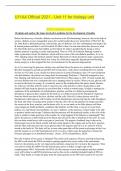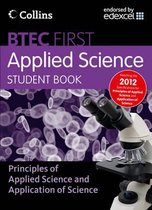U11A4 Official 2021 - Unit 11 for biology unit
BTEC applied science
1.Explain and analyse the stages involved in medicine for the development of insulin.
Before the discovery of insulin, diabetes was known to be life-threatening, however, due to the help of
science, diabetes is now manageable across the world. Insulin discovery started from 1700-1923. By
Dr, John Rollo a British physician, who had the idea of diabetics of a low-carbohydrate diet high in fat
& animal protein and then it was Dr Fedrick M.Allen’s idea of a near-starvation diet, however, what
Dr John Rollo did was not that helpful, as Dr Fedrick M. Allen’s decided that by doing so led to
diabetic patients in getting severely malnourished. Then in 1920, Dr Frederick Banting wanted to
make a pancreatic extract for diabetes, which will have some of the anti-diabetic qualities. As so in
1921, Banting along with medical student Charles Best both of whom decided to make a pancreatic
extract. They used an animal which was a dog, for which they surgically ligated (prevent bleeding
during surgery), as this stopped the flow of nourishment for the pancreas degenerated.
As so, by removing the pancreas, slicing it up, and then freeze the pieces in a solution of water & salt.
But then managed to ground up and filter the frozen pieces. And extract something that was insulin.
So then in 1922 after a year, insulin was then tested on Leonard Thompson, that a 14-year-old patient
who had diabetes, the patient was lying dead, but amazingly Professor. J. Macleod managed to save
him. Banting and Macleod were awarded the Noble Prize in Physiology in 1923. Overall, insulin did
not cure diabetes but was a treatment that was a stepping-stone in science. When you eat, glucose will
be used in the body for energy. It’s created by many of the carbohydrates like pasta, bread, biscuits,
etc. Glucose will then either be used or stored in your cells and this is where insulin plays a part.
Insulin will help keep the glucose in your blood that is within a normal range. It helps to manage the
regulation of the metabolism of carbohydrates, proteins, and fats as it helps in promoting the
absorption of glucose that’s needed for the body as so it helps to promote the absorption of glucose
from the blood into that of the liver, skeletal, and fat cells. After all, it takes glucose out of the
bloodstream which glucose will be taken out of the bloodstream and moving into the cells throughout
the body and what’s amazing about insulin is that the cells will use the glucose for energy and store
the excess in the liver, muscles, and fat tissue cells. As so too much or too little glucose will then
cause dangerous health problems, conditions like diabetes will develop, it can go on to get heart,
kidney, eye, and blood vessel problems. As type 1 diabetes, in the pancreas, it takes longer to be able
to produce insulin and in type 2 diabetes that the pancreas will be produced insulin, as the cells of the
body is unable to make good use of the insulin. So, what happens if the diabetes is unmanaged? This
allows the glucose to then build up in the blood and will not be able to distribute to the cells. As such
this can then wreak havoc with every part of your body. The negative feedback loop is that as the
blood sugar rises in the blood, insulin will then sends signals to the organs such as the liver, muscles,
and the other cells that store the excess glucose that’s the negative part of it as it's stored it will be
stored as the body fat. The body will try to store other parts that will be stored as glycogen in the liver
and the muscles as so if the blood glucose level is too low, which cause the pancreas to release the
hormone glucagon as its distributed around. (Anon., 2019), (StudyMoose, 2020).
How the isolation of two genes is obtained? The amino acid sequence if known can help in knowing,
the DNA code which the DNA can help by putting together the correct order of the nucleotides,
however, the proteins can be very large and would take a long time for it to know the sequence. Then
you need to isolate the mRNA for the desired gene and so it makes a single copy of the
complementary DNA. Afterwards, the DNA uses the enzyme reverse transcriptase and then another
copy will be done to add DNA polymerase and so this can be a doubled stranded length of DNA is
made. Then finally to isolate the gene from the entire genome as the DNA first needs to be cut into
, fragments so the one that contains the desired gene must be identified because the enzymes used to
cut are called restriction enzymes. For step 1: the bacterial plasmids can be used to put the insulin
gene and the DNA from humans that can include the insulin gene. The second step is that once it’s
isolated the bacterial plasmid and the human DNA will be cut as so to remove the DNA to get rid of
the unwanted DNA. Then restriction enzymes will be used as the same enzyme will be used for both
of the DNA, so the results are of sticky ends.
Step 1: Step 2:
Moreover, the DNA fragments will be mixed and cut with plasmids, then will be placed in a test tube,
the sticky ends of the plasmid of the DNA will be formed and the DNA fragments will be joined
together by the formation of hydrogen bonds, and finally using DNA ligase to seal properly. The DNA
ligase is that of the enzyme that will catalyse the joining of sugar and phosphate groups in a strand of
the DNA. Now it's complete.
Step 4: This will require the recombinant plasmid with the bacteria, as so the use of heat shock
transformation will be used and this will require these conditions for these calcium ions to have a high
temperature and this process is explained through this diagram so the normal bacterium will have the
competent cell to have the plasmid bound to the exterior of the cell here in this pink diagram and then
as its left for 2 minutes at 420C and then the plasmid for this transportation into the cell and finally it
will form a transformed cell. Furthermore, this step is essential for DNA cloning as it occurs after
restriction digest and ligation as so it transfers the newly made plasmids and the transformation stage
the bacteria will be selected on the antibiotic plates and this will allow the bacteria that are antibiotic
resistant as so each will form a colony because bacteria colonies with the right plasmids would be
grown to make the large cultures of the identical bacteria that are used to produce plasmid.
Then the culture and purification of the insulin protein, the bacterium individually with have
recombinant plasmid that will produce and as such it will allow isolating the bacterial colonies that
gene this is shown in the diagram below of the process of it. As such bacterial host strain like that of





